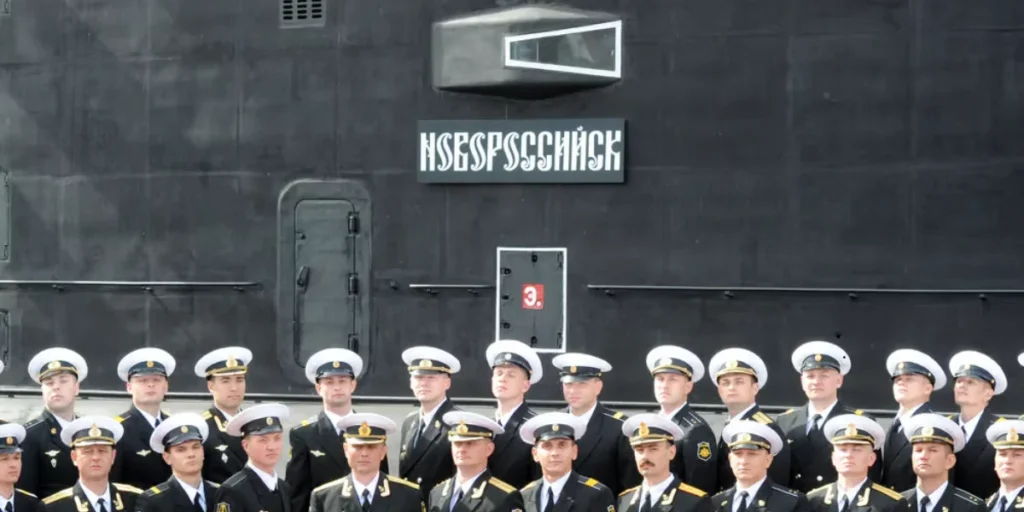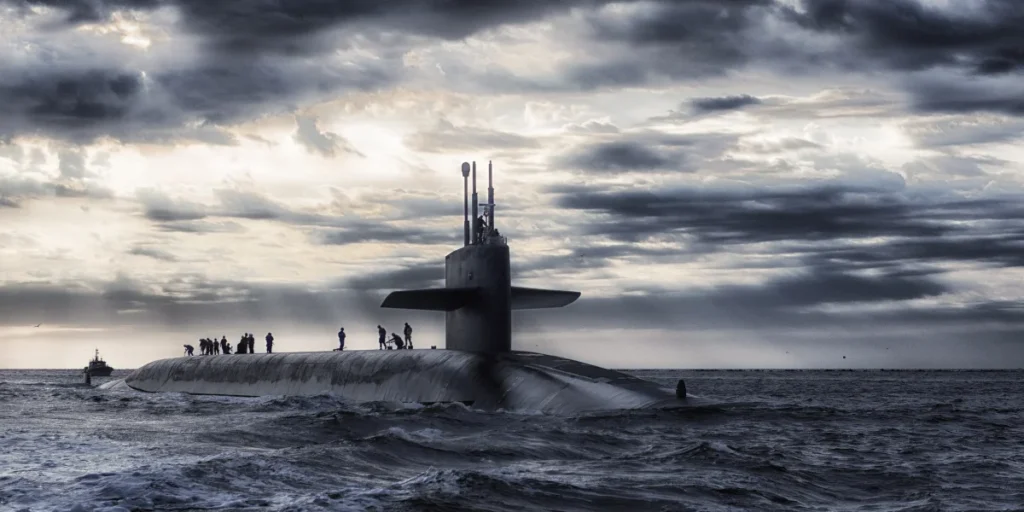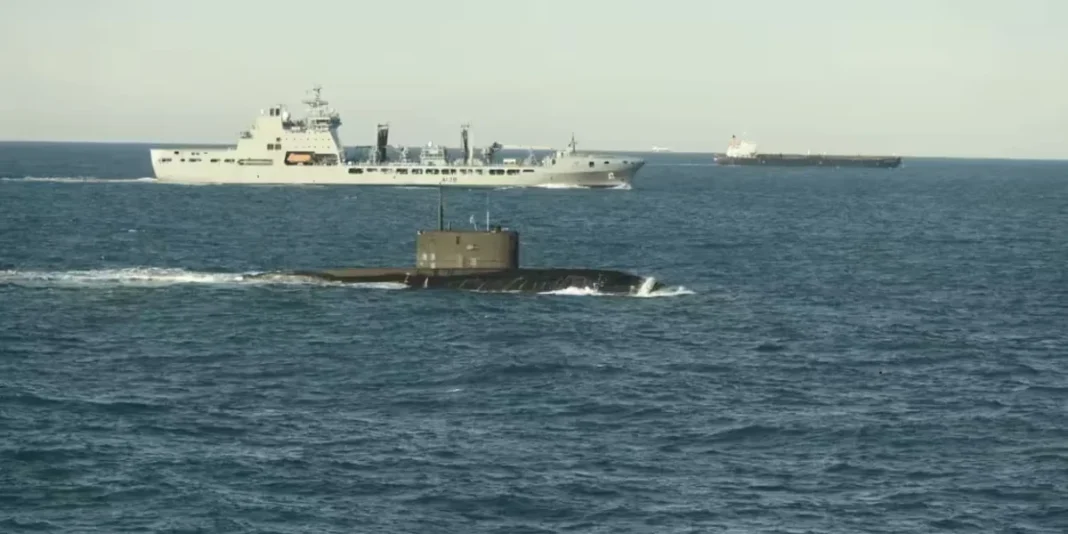A Russian nuclear submarine accident has triggered international concern after the Novorossiysk, a 242-foot Kilo-class vessel, was spotted on the surface near the Strait of Gibraltar on Friday. This unusual appearance has raised alarm bells amongst military observers.
The Russian submarine, which is part of Russia’s Black Sea Fleet, is reportedly experiencing “serious technical problems” with its fuel system. Consequently, the crew may be forced to pump fuel directly into the sea, creating a potential environmental hazard. The diesel-electric attack vessel, launched in August 2014, accommodates typically 52 crew members and has the capacity to remain submerged for up to 45 days.
Furthermore, the situation has drawn disturbing parallels to the Kursk submarine disaster of August 2000, when 118 sailors perished after explosions sank an Oscar II-class submarine in the Barents Sea. Although the Novorossiysk can carry nuclear Kalibr missiles, it is not thought to have been deployed in Russia’s invasion of Ukraine, which has somewhat limited the immediate military implications of this incident.
Russian Submarine Suffers Fuel System Failure in the Mediterranean

Reports indicate that the Russian submarine Novorossiysk is facing a critical malfunction in its fuel system while operating on combat duty in the Mediterranean Sea. According to Russian investigative outlet VChK-OGPU, the vessel reported serious technical problems on September 27, 2025.
The diesel-electric submarine’s primary issue involves damage to its fuel system, causing fuel to leak directly into the bilge compartment. This situation has created a significant hazard aboard the vessel, as the accumulating fuel presents a serious explosion risk.
Military analysts note that the crew faces limited options due to a severe lack of resources. Sources report that neither spare parts for repairs nor qualified specialists aboard the submarine are capable of addressing the malfunctions. Due to these constraints, the crew is unable to fix the problem themselves.
The technical failure has reportedly forced the vessel above water near the Strait of Gibraltar. Sources familiar with the matter believe the crew may have no choice but to start pumping the accumulated fuel from the hold directly into the Mediterranean Sea to prevent a potential catastrophe.
This Russian nuclear submarine accident highlights potentially broader logistical and maintenance challenges within the Russian Navy’s submarine fleet. The vessel, part of Russia’s Black Sea Fleet, was previously observed by the Royal Navy as it sailed through the English Channel and North Sea in July.
Crew Considers Dumping Fuel at Sea
The accumulating fuel in the Novorossiysk’s hold has created an immediate explosion hazard, placing the crew in a perilous situation with limited options. Military analysts describe the scenario as a “volatile situation” inside the submarine, with the risk of catastrophic detonation rising as more diesel fuel collects in enclosed spaces.
Faced with this critical safety threat, sources indicate the crew may have no choice but to begin “pumping out the hold” directly into the Mediterranean Sea. This desperate measure reflects the severity of the crisis aboard the vessel, as accumulated fuel presents a significant ignition risk if left untreated.
The situation is particularly concerning since the submarine remains without the necessary resources to address the malfunction. “There are no spare parts for repairs or qualified specialists on the submarine, and the crew is unable to fix the malfunctions,” reported the VChK-OGPU channel.
This emergency response creates additional complications beyond the immediate safety concerns. Dumping fuel would not only cause environmental damage but also create tactical vulnerabilities through potential detection.

The Russian nuclear submarine accident has evoked comparisons to the tragic Kursk disaster of August 2000, when the Russian Oscar II submarine exploded in the Barents Sea during a naval exercise, resulting in the deaths of all 118 crew members. That catastrophe was linked to leaked hydrogen peroxide, causing a torpedo failure in the forward compartment.
Despite the gravity of the situation, Russian authorities have issued no official statement confirming the vessel is in trouble.
Kursk Disaster Comparisons Raise Alarm Over Safety Protocols
The current crisis aboard the Novorossiysk evokes haunting parallels to the Kursk submarine disaster of 2000, considered one of Russia’s most serious naval catastrophes. Naval experts have noted worrying similarities in maintenance patterns and emergency response capabilities.
On August 12, 2000, the Russian Oscar II-class submarine Kursk sank after a torpedo explosion during naval exercises, ultimately claiming all 118 lives aboard. Notably, 23 sailors survived the initial explosion, taking refuge in the ninth compartment, ultimately succumbing to carbon monoxide poisoning as oxygen supplies dwindled. Investigations revealed the cause was a faulty torpedo containing highly concentrated hydrogen peroxide liquid that had leaked.
The Russian Navy’s response to the Kursk incident was widely condemned as “an appalling mixture of callousness, mendacity, incompetence, and disorganisation”. Officials initially refused international assistance, with Putin authorising British and Norwegian help only five days after the disaster.
Safety experts point out that effective submarine safety hinges upon rigorous maintenance protocols, properly trained personnel, and swift emergency responses—all factors apparently lacking in both incidents.
Comparatively, the United States Navy’s SUBSAFE programme, established following earlier submarine losses, has maintained a perfect safety record since 1963—no SUBSAFE-certified submarine has been lost in nearly six decades.
Conclusion – Russian Nuclear Submarine Accident

The Novorossiysk crisis clearly demonstrates the severe challenges faced by Russia’s submarine fleet. Critical fuel system failures have created an imminent explosion risk, leaving the crew with potentially devastating choices. Dumping fuel directly into the Mediterranean not only poses environmental dangers but also signals operational desperation aboard the vessel.
This emergency undoubtedly raises broader questions about maintenance standards across Russian naval assets. Technical failures of this magnitude rarely occur in isolation; instead, they typically indicate systemic issues throughout fleet operations. The lack of qualified specialists and spare parts aboard highlights significant logistical shortcomings that could affect other vessels similarly.
Comparisons to the Kursk disaster seem particularly apt, especially considering both incidents involved technical malfunctions that placed crews in life-threatening situations. Though Russian authorities have remained silent about Novorossiysk’s predicament, the international community watches closely as events unfold near the strategically vital Strait of Gibraltar.
Military analysts will certainly examine this incident as part of a pattern that might reveal deeper structural problems within Russian naval capabilities. Meanwhile, environmental experts must prepare for possible contamination should fuel dumping become necessary. The submarine’s nuclear capabilities, though reportedly not deployed in Ukraine operations, add another layer of concern to an already precarious situation.
Unless swift intervention occurs, this incident might join the Kursk in Russia’s naval disaster chronicles. The difference, hopefully, lies in the outcome for the 52 crew members currently facing this crisis at sea.
You May Also Be Interested In: Ghost Shark Submarine: Inside Australia’s $1.7bn Autonomous Underwater Fleet
What is the current situation with the Russian submarine Novorossiysk?
The Novorossiysk, a Russian nuclear submarine, has reported a critical fuel system failure while operating in the Mediterranean Sea. The vessel has surfaced near the Strait of Gibraltar due to this malfunction.
What are the main risks associated with the submarine’s malfunction?
The primary concern is the risk of explosion due to fuel accumulating in the submarine’s hold. This situation has created a volatile environment inside the vessel, posing a significant threat to the crew’s safety.
How is the crew planning to address the fuel system failure?
Due to not having of spare parts and qualified specialists on board, the crew is unable to repair the malfunction. They may be forced to consider pumping fuel directly into the sea to prevent a potential catastrophe.
What are the potential environmental impacts of this situation?
If the crew is forced to dump fuel into the Mediterranean Sea, it could cause significant environmental damage. This action would not only harm marine ecosystems but also create additional complications beyond the immediate safety concerns.






